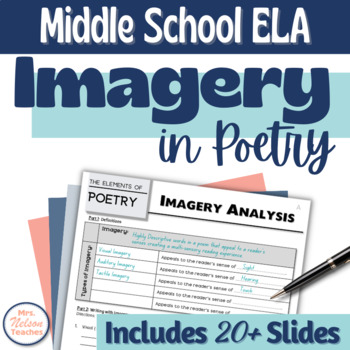Imagery in Poetry Activities Middle School
- PDF
- Easel Activity
Also included in
- Why do we often submit our students to long, dull, (dare I say, torturous) poetry units that they hate? Why not make poetry as fun and exciting as it has the potential to be?This unit does just that! Inside this .pdf file, you will find 10 elements of poetry lesson plans and activities plus a pre anPrice $27.00Original Price $41.49Save $14.49
Description
Help your middle school students identify and analyze imagery in poetry with these no-prep, print-and-go worksheets and Slides Presentation! Using their knowledge of figurative language, students will identify and analyze different types of imagery in poetry.
Everything you need to teach your middle school students how imagery affects a poem is included! Students will learn to identify imagery, determine types of imagery, write with imagery, and describe how imagery affects a poem.
Two differentiated versions of the student assignment are included--the first is great for most students; the second is helpful for students who may struggle to keep up with taking notes! Answer keys are provided for both!
This lesson can be used in a traditional classroom setting OR digitally with TpT's EASEL!
What's Included:
- General Teacher Guidelines and Instructions
- Lesson outline with step-by-step teacher instructions.
- Link to Engaging Google Slides Presentation that will guide you and your students through the lesson and the activities. Over 20 Slides!
- Instruction includes definitions of imagery and types of imagery (visual, auditory, tactile, olfactory, and gustatory).
- Two differentiated assignments for students of varying levels.
- Answer keys for both differentiated assignments.
- Creative Extension Imagery Assignment.
- Full FUN Poetry Unit Preview
Lesson Outline:
- Direct Instruction: Imagery Introduction and Examples
- Types of Imagery (visual, auditory, tactile, olfactory, and gustatory) and examples of each type.
- Guided Practice: Writing with Imagery
- Discussion on How Imagery Affects Poetry
- Teacher Modeling/Guided Practice Analyzing Imagery
- Independent Practice Analyzing Imagery
- Extension: Creative Project Assignment
This Lesson is also Included In:
You Might Also Like:
Freak the Mighty Skills-based Novel Unit
The Witch of Blackbird Pond - Complete Novel Unit
Free Stuff!
Did you know that TpT gives you credits towards future purchases when you leave feedback? Your feedback is so important to me as I try to provide the best products possible! Please go to your "My Purchases" page (you may need to log in). Next to each purchase, you'll see a "Provide Feedback" button. Simply click on the button and it will take you to a page where you can give a quick rating and leave a short comment. Thank you so much for providing valuable feedback!
Connect with Me!
Click on the "Follow Me" button on my store page to see all my latest products and updates!
Follow me on Instagram @mrs.nelson.teaches.
Check out my new blog: mrsnelsonteaches.com







